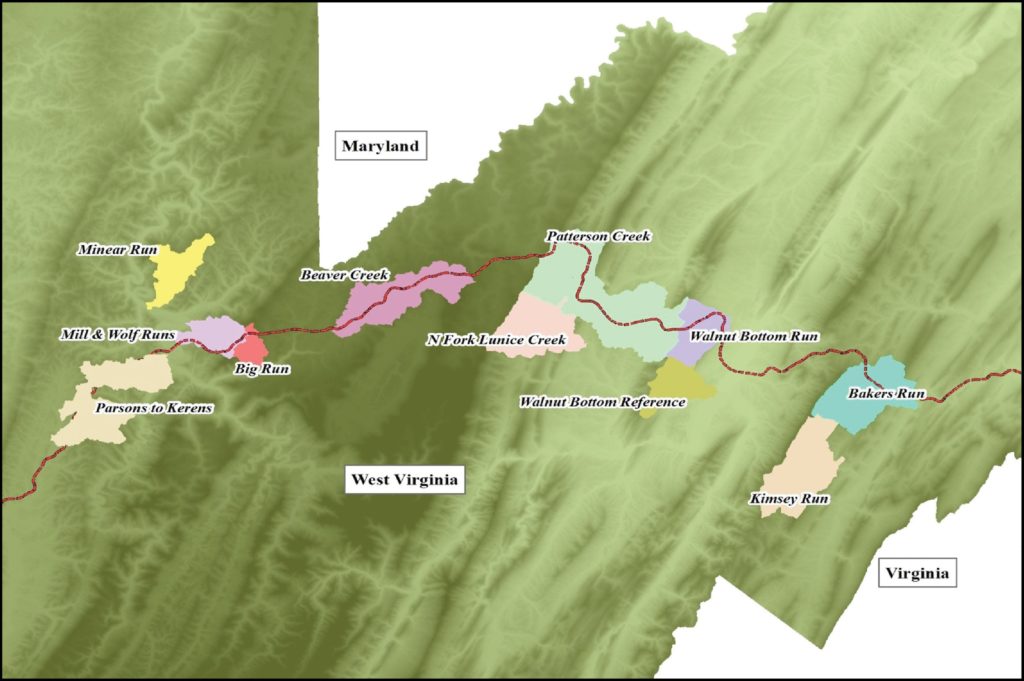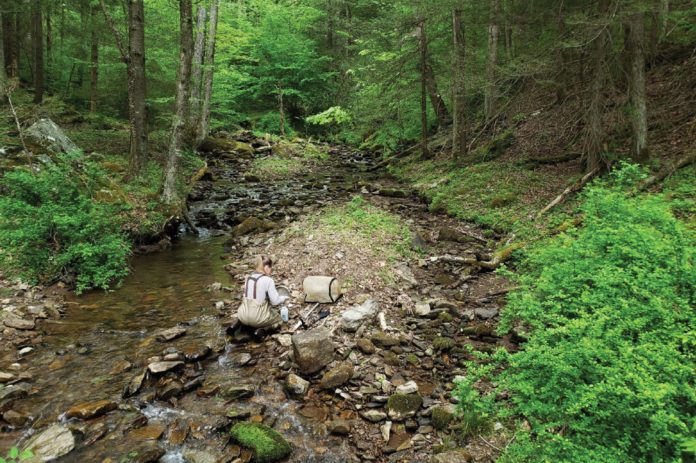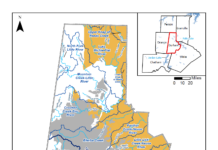Road construction is a substantial disturbance of the terrestrial environment that may also impact stream water quality. Logging and clearing the right of way, blasting through rock and moving large quantities of earth all have the potential to transport sediment into streams increasing turbidity as well as reducing habitat quality for aquatic organisms. Water chemistry may be altered as rock and soil surfaces are exposed to leaching. Additionally, the introduction of large amounts of gravel forming the road base may affect water chemistry as water percolates through it and leaches available ions.
The West Virginia Department of Transportation’s Division of Highways has been constructing Corridor H, a new, 157-mile divided highway that will connect Interstate 79 in central West Virginia to Interstate 81 in western Virginia (Figure 1). Construction started in 2000 and currently 101 miles are completed and open to traffic. The final section of the highway is estimated to be completed in 2034. As part of that construction, researchers have had the opportunity to conduct a long-term study (20+ years) examining the effects of highway construction on water quality in wadeable streams that are adjacent to or cross the new highway. Wadeable streams were selected as they are the types of streams the highway typically crosses, there are substantially more small streams impacted by highway construction and impacts to wadeable streams are propagated downstream to larger rivers.
In each highway segment representative streams were identified, and one or more sampling sites were designated. Multiple sites were designated for streams that paralleled the highway route. Additionally, up- and downstream-sites were selected when the highway crossed a stream. Reference sites that were outside the influence of highway construction were also chosen to monitor impacts unrelated to construction activity. Each site was sampled quarterly for five years before construction started, during construction if access to sites was possible, and for five years after construction was completed. Discharge, pH, specific conductance, and turbidity were measured in field (Figure 2). Total suspended solids (TSS), alkalinity, acidity, chloride, sulfate, iron, calcium, magnesium, manganese, aluminum, nitrite, nitrate, ammonium and total phosphate concentrations were determined by colorimetric, potentiometric or absorption spectroscopic methods in the lab.

Results for Three Segments
This article describes the findings for three segments where construction has been completed and the five-year post-construction sampling has concluded. The first segment, Walnut Bottom, is small with only five sites and one reference site. The second segment, Patterson Creek, is larger with 10 sites and two reference sites. Both Walnut Bottom and Patterson Creek are primarily agricultural with large areas devoted to grazing cattle. The third segment, Beaver Creek, has nine sites with one reference site. Approximately half of Beaver Creek is impacted by abandoned or active coal mining.
Researchers examined whether there were differences in any of the parameters between construction phases (pre-construction, during construction and post-construction) at the sites in the three segments. Surprisingly, very few sites had significant differences in turbidity or TSS. Two sites in Walnut Bottom had significant decreases in TSS after construction primarily due to a reduction in the presence of grazing cattle near the sampling sites. This is an indication that sediment control devices, including sediment fences and sediment control ponds, were used effectively.
Specific conductance increased after highway construction at all sites in the Walnut Bottom and Patterson Creek segments. At most sites the increases were statistically significant. In general, this corresponded to increases in alkalinity and calcium, magnesium, sulfate and chloride concentrations. The same pattern was observed for sites in the Beaver Creek segment that were not impacted by coal mining. There was little difference in specific conductance between construction phases at most of the mining impacted sites, which had high specific conductance before construction. In general, alkalinity and calcium concentrations increased after highway construction at these sites as well. Increases in alkalinity and calcium, magnesium and sulfate concentrations could be due to leaching of newly exposed rock and soil surfaces or leaching of the sub-grade gravel beneath the concrete pavement surface.
In the Walnut Bottom and Patterson Creek segments all sites had higher nitrate concentrations post-construction independent of short term increases due to revegetation activities. Similar increases, but at a lower magnitude, were observed at the reference sites, indicating that while regionwide nitrate concentrations were increasing, highway construction was affecting nitrate concentrations as well. The highest concentrations occurred in small streams where a large percentage of the watershed was disturbed by construction activities including logging and large-scale earth moving. In one stream in particular, nitrate concentrations that averaged 0.5 mg/L before construction, had a post-construction average of 4.6 mg/L and did not appear to be decreasing. The Beaver Creek sites, which are in a less fertile area and did not have as large an area disturbed by construction, did not have post-construction increases in nitrate concentrations.
This study demonstrated that the implementation of best management practices such as sediment fences and sediment ponds were effective at keeping sediment out of streams within the highway construction zone. However, the extensive disturbances involved in road construction did cause some increases in soluble constituents including calcium, magnesium, sulfate, chloride and nitrate.
Given the diffuse source, likely from exposed soils and its chemical characteristics — highly dissolved and fairly low concent-rations for known treatment methods — recommendations on reduction of soluble constituents during and after construction are likely to be site-specific depending on those factors.
About the Experts
Karen Buzby, Ph.D, is a research associate in the Wadsworth Department of Civil and Environmental Engineering at West Virginia University interested in stream water quality.
Lian-Shin Lin, Ph.D., PE, is a Professor in the same department. His research interests include development of novel water and wastewater technologies, and watershed assessment.
About the Project
Funding for the Corridor H Stream Study has been provided by the West Virginia Department of Transportation’s Division of Highways. More information on the study can be found in the following publication “Effects of Highway Construction on Stream Water Quality and Macroinvertebrate Condition in a Mid-Atlantic Highlands Watershed, USA” by Y. Chen, R.C. Viadero, Jr., X. Wei, R. Fortney, L.B. Hedrick, S.A. Welsh, and L.S. Lin. Journal of Environmental Quality 38:1672-1682.













